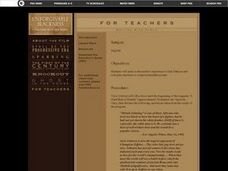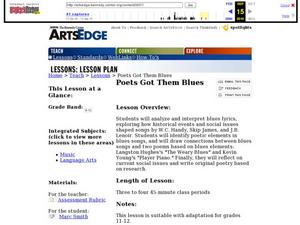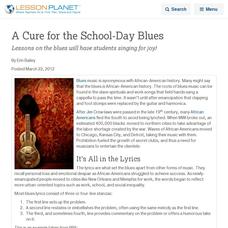Anti-Defamation League
What are Reparations and Should We Enact Them?
Young social scientists investigate recent legislative proposals for reparations for African Americans. They examine the rationale behind the proposals by viewing videos and reading related articles. To close the lesson plan, scholars...
Curated OER
Civil Rights through Photographs
Students examine why racial tensions continued after laws were put into place to try and create equal treatment. In this two part Civil Rights lesson, students explored the causes of the movement through photography and a PowerPoint...
Education World
Now Let Me Fly -- A Black History Reader's Theater Script
Young scholars study African American history, Jim Crow laws, and seperate but equal statutes by performing a Reader's Theater script. They perform Marcia Cebulska's, Now Let Me Fly, which may be requested online.
Curated OER
The First & Fourteenth Amendments
Students analyze the historical implications of the First Amendment of 1791 and the Fourteenth Amendment of 1868, upon American Indians and African Americans. They consider the applicability of the 14th Amendment to African Americans in...
Curated OER
Using and Creating Timelines
Eleventh graders analyze information presented in a timeline and then create a time line. They put the following events in order from oldest to recent: Telephone invented (1876), Massacre at Wounded Knee (1890), First transcontinental...
Facing History and Ourselves
Emmett Till: Choosing to Remember
Mamie Till, the mother of Emmett Till and civil rights activist, believed that her son's murder was the last straw before public outrage over racial injustice spilled over into the Civil Rights Movement of the 20th century. A history...
PBS
Jackie Robinson: Athlete and Activist
Can hitting a home run be an act of courage? Scholars analyze the impact Jackie Robinson had on the Civil Rights movement in America. They use primary sources and video clips to create 21st-Century baseball cards of Robinson's many...
Albert Shanker Institute
Who Was Bayard Rustin?
Who was Bayard Rustin? Pupils analyze a series of primary source documents to learn about this important figure in the civil rights movement. The activity contains a short film to watch along with guiding questions and other resources...
EngageNY
Grade 11 ELA Module 2: Unit 1, Lesson 13
Some words leave a lasting impact. After reading paragraph 11 of the text "Of Our Spiritual Strivings," scholars closely examine how Du Bois describes the impact prejudice left on the African American community. They discuss the...
Curated OER
Recognizing that One Text Can Generate Multiple Interpretations - The Double V
Students research African American involvement in World War II and the Double V campaign. In this African American history lesson plan, students review Jim Crow and watch a related video. Students complete the Double V image graphic...
Curated OER
What was life like for African Americans after the Reconstruction?
Students examine the origins and effects of Jim Crow laws and how specific legislation supported segregation. The lesson provides foundational, historical background for unit on the media's role in the social justice campaign of the...
Curated OER
Writing With Punch
High schoolers watch the series "Unforgiveable Blackness". They examine the media's response to Jack Johnson in the film. They role-play the role of reporters to compose poems of headlines.
Curated OER
African Americans in World War II: Staging a Double V Campaign in the Classroom
The feelings and attitudes of African-Americans during World War II are examined by high schoolers. After watching various clips from "The War," they answer comprehension questions for each section. In groups, they create their own...
Curated OER
Poets Got Them Blues
Contemplate what music learners listen to and why they listen. Can they find poetry within music lyrics? Specifically hone in on blues lyrics and ruminate upon the social issues prevalent in the themes. Particular song lyrics coincide...
Alabama Department of Archives and History
Two Different African-American Visions: W.E.B. Du Bois and Booker T. Washington
The strategies civil rights activists Booker T. Washington and W.E.B. Du Bois proposed for blacks to achieve racial progress is the focus of an activity in which class groups identify the strategies as well as the benefits and drawbacks...
National Endowment for the Humanities
The Music of African American History
High schoolers examine role spirituals have played in African American history and religion, examine Harriet Tubman's use of spirituals in her work, explore power of spirituals in Civil Rights Movement, and work with oral tradition,...
Curated OER
Lesson 2-Profiles in Courage: To Kill A Mockingbird and the Scottsboro Boys Trial
Review one of the most memorable cases in the history of the United States. After reading To Kill A Mockingbird, young scholars read and select court transcripts and other primary source material from the Scottsboro Boys Trial of 1933....
Defining US
Integration of Education and American Society
How did the struggle for Civil Rights during the 1950s transform American society and politics? Why are American schools integrated today? Class members explore these essential questions by examining a series of primary and secondary...
Curated OER
A Cure for the School-Day Blues
Lessons on the Blues will have students singing for joy!
Alabama Department of Archives and History
Clotilde, The Last Slave Ship
The Clotilde was the last known ship to bring slaves from Africa to the United States - good riddance! Dive into the details of the ship, its cargo, origin, and route, and learn about the future of the Africans on board with a...
Curated OER
To Kill a Mockingbird Historical Background Study Guide
Truly understanding a story means understanding its setting and historical background. This guide, prepared for To Kill a Mockingbird, encourages your class to explore the Great Depression, Hoovervilles, and the Scottsboro trials....
Curated OER
To Kill A Mockingbird: Historical Background
Dorothea Lange's "Migrant Mother" and other images set the stage for a PowerPoint about the Great Depression. Whether used as background for Harper Lee's To Kill a Mockingbird, or as part of a historical study, the presentation would...
Roy Rosenzweig Center for History and New Media
The Homestead Act
To understand how the Homestead Act of 1862 changed the US and the lives of the people during that time, class members examine primary source materials including letters, broadsides, and images. They then assume the voice of a...
West Jefferson High School
The Novel — Honor
For classes tackling To Kill a Mockingbird, this lesson plan sets readers up for discussions or essay writing with questions and prompts. The prompts encourage individuals to explore beyond the novel itself, looking at photographs from...
Other popular searches
- Jim Crow Laws
- Jim Crow Era
- Jim Crow Reading
- Jim Crow Laws 1900s
- Segregation Jim Crow Laws
- What Is Jim Crow
- Jim Crow Laws 1866
- Law Jim Crow
- Jim Crow Laws Reconstruction
- Jim Crow South
- Jim Crow Laws History
- Pbs and Jim Crow

























